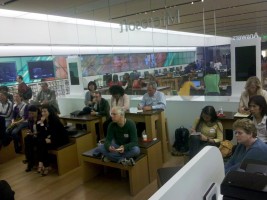This post was originally published Mar. 25, 2011, for the Asian American Journalists Association.
How to do social media right: experiment, screw up and ask for forgiveness.
Repeat until you succeed.
“Be fearless,” said Kevin Sablan, head of the Orange County Register’s web efforts and new-media leader. He gave a presentation Wednesday on social media and innovation, presented by the Asian American Journalists Association of San Diego.

The audience at AAJA-San Diego's program on social media and innovation at the Microsoft Store in San Diego, California, on March 23, 2011.
Sablan, AAJA-San Diego’s first speaker of 2011, told the journalists and public relations professionals in attendance that even successful companies like Google have made their share of mistakes. He took us through its product graveyard that houses forgettable products including Google Buzz, its answer to Twitter and Facebook, and Google Wave, which was supposed to make-over Gmail.
Both were flops, Sablan said, but showed the importance of trying something new, giving up when things don’t work and not belaboring failure.
Sablan, a respected member of the Web journalism community, also talked about tools that help people filter, group and make sense of the noise on Facebook, Twitter and other social-media channels.
